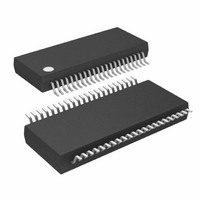ATMEGA32HVB-8X3 Atmel, ATMEGA32HVB-8X3 Datasheet - Page 172

ATMEGA32HVB-8X3
Manufacturer Part Number
ATMEGA32HVB-8X3
Description
MCU AVR 32KB FLASH 8MHZ 44TSSOP
Manufacturer
Atmel
Series
AVR® ATmegar
Specifications of ATMEGA32HVB-8X3
Core Processor
AVR
Core Size
8-Bit
Speed
8MHz
Connectivity
I²C, SPI
Peripherals
POR, WDT
Number Of I /o
17
Program Memory Size
32KB (16K x 16)
Program Memory Type
FLASH
Eeprom Size
1K x 8
Ram Size
2K x 8
Voltage - Supply (vcc/vdd)
4 V ~ 25 V
Data Converters
A/D 7x12b
Oscillator Type
External
Operating Temperature
-40°C ~ 85°C
Package / Case
44-TSSOP
Processor Series
ATMEGA32x
Core
AVR8
Data Bus Width
8 bit
Data Ram Size
2 KB
Interface Type
SPI, TWI
Maximum Clock Frequency
8 MHz
Number Of Programmable I/os
17
Number Of Timers
2
Maximum Operating Temperature
+ 85 C
Mounting Style
SMD/SMT
Development Tools By Supplier
ATAVRDRAGON, ATSTK500, ATSTK600, ATAVRISP2, ATAVRONEKIT, ATAVRSB200
Minimum Operating Temperature
- 40 C
On-chip Adc
12 bit, 7 Channel
Package
44TSSOP
Device Core
AVR
Family Name
ATmega
Maximum Speed
8 MHz
Operating Supply Voltage
5|9|12|15|18|24 V
For Use With
ATSTK524 - KIT STARTER ATMEGA32M1/MEGA32C1ATSTK600 - DEV KIT FOR AVR/AVR32ATAVRDRAGON - KIT DRAGON 32KB FLASH MEM AVRATSTK500 - PROGRAMMER AVR STARTER KIT
Lead Free Status / RoHS Status
Lead free / RoHS Compliant
Available stocks
Company
Part Number
Manufacturer
Quantity
Price
Company:
Part Number:
ATMEGA32HVB-8X3
Manufacturer:
Atmel
Quantity:
408
- Current page: 172 of 275
- Download datasheet (7Mb)
27.7.2
8042B–AVR–06/10
Master Receiver Mode
In the Master Receiver mode, a number of data bytes are received from a slave transmitter (see
Figure
mat of the following address packet determines whether Master Transmitter or Master Receiver
mode is to be entered. If SLA+W is transmitted, MT mode is entered, if SLA+R is transmitted,
MR mode is entered. All the status codes mentioned in this section assume that the prescaler
bits are zero or are masked to zero.
Figure 27-13. Data Transfer in Master Receiver Mode
A START condition is sent by writing the following value to TWCR:
TWEN must be written to one to enable the Two-wire Serial Interface, TWSTA must be written to
one to transmit a START condition and TWINT must be set to clear the TWINT flag. The TWI will
then test the Two-wire Serial Bus and generate a START condition as soon as the bus becomes
free. After a START condition has been transmitted, the TWINT flag is set by hardware, and the
status code in TWSR will be 0x08 (see
SLA+R must be transmitted. This is done by writing SLA+R to TWDR. Thereafter the TWINT bit
should be cleared (by writing it to one) to continue the transfer. This is accomplished by writing
the following value to TWCR:
When SLA+R have been transmitted and an acknowledgment bit has been received, TWINT is
set again and a number of status codes in TWSR are possible. Possible status codes in Master
mode are 0x38, 0x40, or 0x48. The appropriate action to be taken for each of these status codes
is detailed in
when the TWINT flag is set high by hardware. This scheme is repeated until the last byte has
been received. After the last byte has been received, the MR should inform the ST by sending a
NACK after the last received data byte. The transfer is ended by generating a STOP condition or
a repeated START condition. A STOP condition is generated by writing the following value to
TWCR:
TWCR
Value
TWCR
Value
SDA
SCL
27-13). In order to enter a Master mode, a START condition must be transmitted. The for-
Device 1
RECEIVER
MASTER
Table 27-12 on page
TWINT
TWINT
1
1
TRANSMITTER
TWEA
TWEA
Device 2
SLAVE
X
X
TWSTA
TWSTA
171. Received data can be read from the TWDR Register
1
0
Device 3
Table 27-2 on page
TWSTO
TWSTO
0
0
........
ATmega16HVB/32HVB
TWWC
TWWC
X
X
Device n
170). In order to enter MR mode,
V
BUS
TWEN
TWEN
1
1
R1
–
0
–
0
R2
TWIE
TWIE
X
X
172
Related parts for ATMEGA32HVB-8X3
Image
Part Number
Description
Manufacturer
Datasheet
Request
R

Part Number:
Description:
Manufacturer:
Atmel Corporation
Datasheet:

Part Number:
Description:
Manufacturer:
ATMEL Corporation
Datasheet:

Part Number:
Description:
IC AVR MCU 32K 16MHZ 5V 44-QFN
Manufacturer:
Atmel
Datasheet:

Part Number:
Description:
IC AVR MCU 32K 16MHZ 5V 40DIP
Manufacturer:
Atmel
Datasheet:

Part Number:
Description:
IC AVR MCU 32K 16MHZ 5V 44TQFP
Manufacturer:
Atmel
Datasheet:

Part Number:
Description:
IC AVR MCU 32K 16MHZ IND 40-DIP
Manufacturer:
Atmel
Datasheet:

Part Number:
Description:
IC AVR MCU 32K 16MHZ IND 44-TQFP
Manufacturer:
Atmel
Datasheet:

Part Number:
Description:
MCU AVR 32KB FLASH 16MHZ 44TQFP
Manufacturer:
Atmel
Datasheet:

Part Number:
Description:
MCU AVR 32KB FLASH 16MHZ 44QFN
Manufacturer:
Atmel
Datasheet:

Part Number:
Description:
MCU AVR 32K FLASH 16MHZ 44-TQFP
Manufacturer:
Atmel
Datasheet:

Part Number:
Description:
IC AVR MCU 32K 16MHZ COM 40-DIP
Manufacturer:
Atmel
Datasheet:

Part Number:
Description:
IC AVR MCU 32K 16MHZ COM 44-QFN
Manufacturer:
Atmel
Datasheet:

Part Number:
Description:
IC AVR MCU 32K 16MHZ COM 44-TQFP
Manufacturer:
Atmel
Datasheet:











